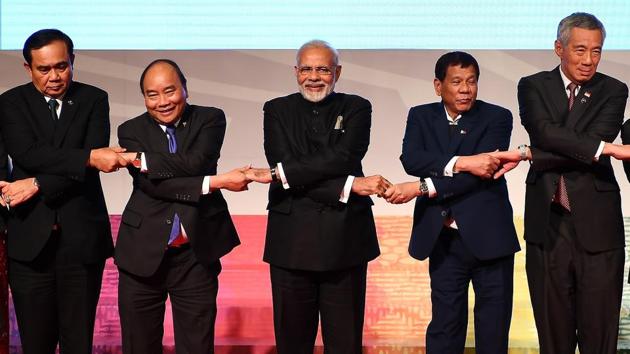India-Asean ties: An incremental relationship that’s set to move ahead
As seen in history, India-Asean ties will be influenced by the wider world, and it will be test the strength of this relationship. The China factor must be seen in this context
The India-Asean summit centres on the presence of 10 heads of state and government at the Republic Day Parade. This is an optically powerful statement of how much India’s relations with South East Asia have progressed since a Look East Policy was first articulated by Prime Minister PV Narasimha Rao in 1992 in Singapore.

Five years ago, in December 2012, all the Asean heads were also in Delhi to observe the 20th anniversary of the partnership. Then, too, as now, debate and discussion on the half empty or the half full part of the India-Asean glass took place. Nevertheless, the larger point is certainly that this has been from the very beginning an incremental relationship and possibly will continue to be so.
Within the Asean framework, incremental growth is also seen as a virtue in itself: India became a sectoral partner of the Asean in 1992, a dialogue partner in 1996 and a summit level partner in 2002. In 2012, the New Delhi summit declared the relationship elevated to a ‘strategic partnership’. The vision statement that had emerged then had outlined its different dimensions: political and security related; economic and trade related; and, finally, those relating to connectivity and cultural lineages. In November 2014, in Naypyitaw, Myanmar, Prime Minister Narendra Modi formally enunciated the Act East Policy.
As one contemplates a quarter century of intense interaction, it is also useful to look further back on how the journey started.
It is well known that the end of the Cold War, the break-up of the Soviet Union and the opening up of the Indian economy were among the cluster of changes in which Look East was then embedded. Asean itself was also affected by the wider changes taking place at the time. The final settlement of the Kampuchea or Cambodian issue paved the way for Vietnam’s subsequent entry into Asean. It is useful to recall how divisive these issues were through the 1980s and how much this had influenced India’s relations at the time with the then constituent members of Asean. Much as the Cold War kept South East Asia divided and stopped Asean from moving ahead on key areas of cooperation. It similarly was a barrier in a smooth interface developing with India.
The central takeaway from reading that history is that the wider world will inevitably intrude on India-Asean ties in the future also and the key would be to make the relationship meaty and meaningful enough to withstand these vicissitudes. The China factor on which reams are written has to be seen in this context as the quality of the relationship China has with each Asean nation varies almost as much as does India’s.
Outside of the political and economic, there is a whole world of shared heritage and culture. The commemorative events for the summit include a good representation of this universe — dance, music, the heritage of the Ramayana, archaeology, among others. It is useful to acknowledge also how much scholarship in India and elsewhere has contributed to keeping alive these memories.
The study of the India-South East Asian interface from the early 20th century was very much of a transnational exercise and numerous scholars and institutions in India and elsewhere made it as such. French scholar Sylvain Levi contributed greatly to inspiring the study of ancient India and its links with South East Asia.
Kalidas Nag, Baij Nath Puri, Devaprasad Ghosh, Suniti Kumar Chatterji, RC Majumdar, KA Nilakanta Sastri are among many others who did so much to gather and further knowledge of how Indians and the people of South East Asia interacted across the millennia. These scholars and intellectuals gave to scholarship in India about South East Asia both an international profile and reputation as also a universalistic impulse. This led, for instance, to the publication of the classic study Sanskrit in Indonesia by Dutch scholar J Gonda in Nagpur in 1952.
It is useful to recall this intellectual heritage also because much of this scholarship was carried out when India was as still a colony and it required an intellectual leap of faith to establish an older relationship of art, culture and literature with South East Asia.
The renewed focus on India and Asean will hopefully also help to strengthen and consolidate this rich tradition of scholarship in India and elsewhere as the relationship progresses and matures in other fields.
TCA Raghavan is former Indian high commissioner to Singapore and Pakistan
The views expressed are personal





